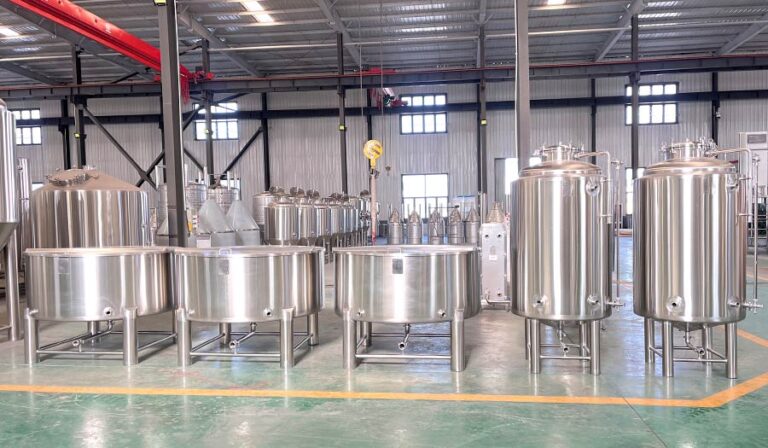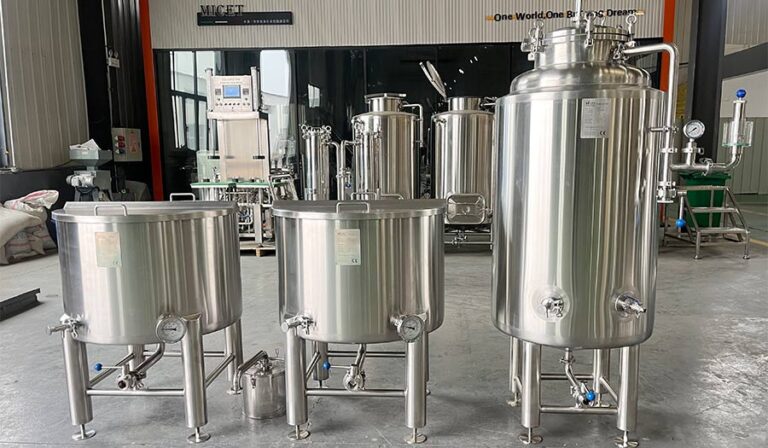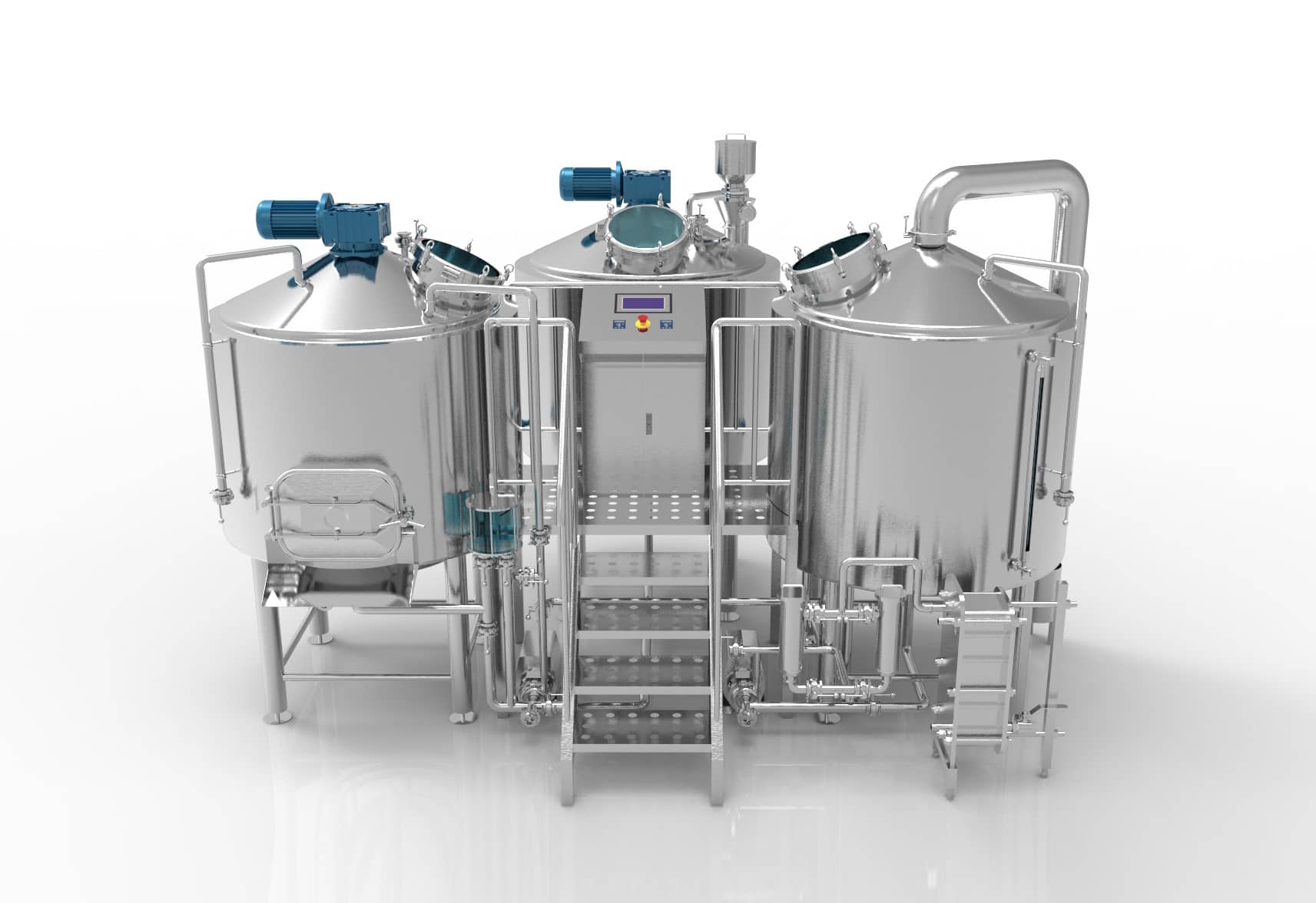In recent years, kombucha has become one of the most popular health beverages worldwide. From North America to Europe and Southeast Asia, consumers are increasingly seeking natural, organic, and probiotic drinks. Whether you are a home enthusiast or a small-scale entrepreneur, more and more people are investing in equipo de elaboración de kombucha to master the art of making healthy beverages at home or to build their own kombucha brand in the market.
However, with the wide variety of equipment types, brands, and specifications available, choosing the right small-scale kombucha brewing equipment that truly fits your needs can be challenging for beginners and business starters alike. This article will provide a comprehensive and practical buying guide from both home and commercial perspectives.
Basic Components of Kombucha Brewing Equipment
Recipiente de fermentación
En recipiente de fermentación is the core of kombucha brewing. Common materials include:
- Glass jars: Ideal for home use and small-batch brewing, allowing easy observation of the fermentation process.
- Stainless steel tanks (304 or 316 grade): Corrosion-resistant, easy to clean, suitable for commercial or large-scale production.
Food-grade plastic containers: Lightweight and low-cost, but prone to scratches; not recommended for long-term use.

Temperature Controller
The ideal fermentation temperature for kombucha is 25°C–30°C. High-quality kombucha brewing equipment often comes with an automatic temperature control feature, ensuring stable fermentation, enhancing microbial activity, and maintaining consistent flavor.
Filtration and Bottling System
After fermentation, the tea needs to be filtered to remove tea leaves and the SCOBY (symbiotic culture of bacteria and yeast), then bottled. Commercial equipment typically includes automatic filtration and bottling systems with capping functions, while home systems usually allow for manual filtration and bottling.
Secondary Fermentation Equipment
To achieve richer carbonation and flavor, kombucha often undergoes a secondary fermentation. This can be done using glass bottles with safety valves or small pressure tanks, depending on the desired volume and carbonation level.
Cleaning and Sanitization Accessories
Maintaining hygiene is critical. Choose kombucha brewing equipment with easy-to-clean designs, and consider using food-grade cleaning agents or a CIP (Clean-in-Place) system to ensure sanitation and prevent contamination.
Home Kombucha Brewing Equipment Buying Guide
Clarify Your Purpose and Brewing Goals
Before choosing home kombucha brewing equipment, it’s essential to define your purpose. Are you looking to make a few bottles occasionally for personal consumption, or do you plan to brew regularly to replace store-bought beverages? For casual use, small-capacity equipment is sufficient. However, if you plan to brew frequently or share with family and friends, a scalable kit is recommended. Knowing your goals helps you make informed decisions regarding capacity, material, and budget.
Choose the Right Capacity
Capacity is one of the most important factors for home kombucha equipment. For beginners, 1–3 liter glass fermenters are usually sufficient and allow you to observe the fermentation process. For larger households or those wishing to brew more at once, 5–10 liter kits are preferable. Keep in mind that kombucha typically ferments for 7–10 days; choosing the right capacity ensures continuous brewing without unnecessary delays or waste.
Material Selection: Safety and Durability
The material of home kombucha brewing equipment affects both safety and flavor. Common materials include borosilicate glass, food-grade stainless steel (304), and some food-grade plastics.Glass fermenters are transparent and allow easy monitoring of tea color and SCOBY development, making them ideal for beginners.
Stainless steel equipment is corrosion-resistant and easy to clean, suitable for long-term use.
Plastic containers are lightweight and inexpensive but prone to scratches and odor retention; they are not recommended for acidic fermentation.If possible, choose glass fermenters with stainless steel spigots to combine safety with convenience.
Importance of Temperature Control
The ideal fermentation temperature for kombucha is 25°C–30°C. Temperatures that are too low can reduce microbial activity, while too high temperatures can inhibit yeast growth and affect flavor and carbonation. For home users, equipment with built-in temperature control or a fermentation heating belt is recommended, especially in colder climates, to ensure stable fermentation and consistent taste.
Ease of Operation and Cleaning
Home users value simplicity and ease of cleaning. Equipment with fewer parts and straightforward design is easier to maintain. Ideal home kits should include:
- Detachable spigots for easy pouring;
- Wide-mouth vessels for adding tea and SCOBY;
- Smooth inner walls to reduce residue and cleaning dead spots.

Accessories and Practical Tools
Useful accessories can improve your brewing experience and ensure consistent flavor:
- pH test strips to monitor acidity;
- Food-grade thermometer for precise temperature control;
- Filters and funnels for clean bottling;
- Glass storage bottles for secondary fermentation and flavor blending.
Budget and Value Considerations
Home kombucha brewing equipment typically ranges from $30 to $150, depending on material, capacity, and features. Beginners can start with a basic kit and upgrade later to models with temperature control or automatic venting. Focus on cost-effectiveness and suitability for your needs rather than just price. Some high-quality international brands also offer OEM options and replaceable accessories, improving long-term value.
Quality Assurance and Brand Reputation
When purchasing kombucha brewing equipment, choose brands or manufacturers with food-grade certifications (e.g., LFGB, FDA, SGS) to ensure safety and reliability. If buying from cross-border e-commerce platforms or overseas suppliers, check customer reviews, product inspection reports, and after-sales policies. A trustworthy supplier provides not only quality equipment but also guidance and technical support.
Commercial Small-Scale Kombucha Brewing Equipment Buying Guide
Define Production Capacity and Market Position
Before purchasing commercial small-scale kombucha brewing equipment, it’s essential to define your brand’s production goals and market positioning. For cafes, health beverage bars, or startup brands, 20–100 liter stainless steel fermenters are usually sufficient for daily sales. If you plan to enter the retail market or produce bottled kombucha, consider modular systems of 200 liters or more to support continuous fermentation and batch production. Modular equipment allows flexible capacity expansion as your business grows, avoiding repeated investments.
Focus on Material Quality and Food-Grade Standards
Commercial kombucha production demands strict hygiene standards. Equipment materials must be acid-resistant, corrosion-resistant, and easy to clean. 304 or 316 food-grade stainless steel is recommended, as it effectively resists acidic corrosion and ensures long-term durability. Additionally, confirm that the equipment complies with FDA, CE, or HACCP certifications to ensure safe use and smooth access to international markets.
Prioritize Automation and Intelligent Features
Modern commercial kombucha brewing equipment should include automatic temperature control, liquid level monitoring, and CIP (Clean-in-Place) cleaning systems to improve production efficiency and consistency. Systems equipped with PLC control panels and pressure safety valves help operators precisely manage the fermentation process, reducing human error and ensuring consistent flavor and quality in every batch.
Pay Attention to Cleaning and Maintenance
Hygiene is critical in kombucha production. When selecting equipment, prioritize models with polished inner surfaces, detachable valves, and automatic cleaning features to prevent bacterial contamination and simplify maintenance, saving both time and labor.
Balance Investment and Long-Term Scalability
For growing brands, it is important to choose cost-effective, expandable kombucha brewing equipment. A high-quality, easy-to-maintain, and scalable system not only provides operational flexibility during the startup phase but also lays a solid foundation for future large-scale production and brand growth.

Key Factors Affecting Kombucha Brewing
Temperature Stability
Temperature is a core factor influencing both the fermentation speed and flavor of kombucha. The ideal fermentation range is typically 25°C–30°C. Temperatures that are too low can reduce yeast activity and slow fermentation, while excessively high temperatures may inhibit beneficial bacteria and affect taste. Choosing kombucha brewing equipment with temperature control ensures a consistent fermentation environment and stable flavor in every batch.
Oxygen and Aeration Design
Kombucha fermentation is an aerobic process, meaning that the supply of oxygen directly affects microbial activity. The design of the vessel, lid material, and ventilation of the fermentation environment all influence oxygen flow. Using breathable covers or fermenters with vent valves can prevent oxygen deficiency, which may lead to bland flavor or abnormal SCOBY growth.
Material Compatibility
The acidic liquid produced during fermentation can react with certain metals, potentially affecting flavor and safety. Therefore, selecting food-grade stainless steel or glass kombucha brewing equipment is crucial to avoid unwanted chemical reactions, maintain flavor integrity, and prevent equipment corrosion.
Yeast and Bacterial Balance
The flavor and carbonation of kombucha largely depend on the balance between yeast and acetic acid bacteria. Using healthy, active cultures and maintaining proper ratios ensures even fermentation and consistent taste. Some equipment comes with mixing and venting functions to help maintain microbial balance, improving success rates.
Limpieza y saneamiento
Equipment cleanliness directly impacts the quality and safety of kombucha. Residual tea leaves or SCOBY fragments can harbor unwanted bacteria, causing fermentation failure or off-flavors. Choosing easy-to-clean, detachable kombucha brewing equipment and performing regular sanitation is key to successful fermentation.
How to Maintain Your Kombucha Brewing Equipment?
Daily Cleaning and Sanitization
Keeping your kombucha brewing equipment clean is essential for preserving tea flavor and ensuring fermentation safety. After each use, rinse the equipment thoroughly to remove tea residue and SCOBY remains. It’s recommended to use food-grade cleaning agents or mild sanitizing solutions to avoid corrosion or harmful residue. For glass or stainless-steel fermenters, use a soft brush to clean the inner walls, ensuring there are no dead corners or build-up.
Regular Inspection of Key Components
Key parts of kombucha brewing equipment—such as spigots, seals, temperature controllers, and valves—should be inspected regularly to ensure they are in good condition. Damaged or aging parts may cause leaks, temperature control failures, or bacterial contamination. Depending on how frequently the equipment is used, conduct a thorough inspection every month or quarter, and replace worn components promptly.
Temperature Control System Maintenance
If your kombucha brewing equipment includes a temperature control system, calibrate it regularly to keep the fermentation temperature within the ideal range of 25°C–30°C. Significant fluctuations can affect microbial activity and flavor quality. For electrically heated or cooled systems, maintain good ventilation and prevent moisture buildup to extend the lifespan of the equipment.
Precautions Before and After Use
Before using your equipment, make sure all components are clean and that the fermenter is free of cracks or damage. During use, avoid direct sunlight or extreme temperatures to prevent over-acidification or equipment degradation. Once fermentation is complete, transfer the kombucha promptly to prevent sediment buildup and bacterial contamination.
Long-Term Storage and Care
If you don’t plan to use your kombucha brewing equipment for an extended period, thoroughly clean, sanitize, and air-dry all parts to prevent rust or mold. For stainless steel or metal components, apply a small amount of food-grade anti-rust oil for protection. Store the equipment in a dry, well-ventilated environment, and avoid heavy pressure or impact to keep it safe and ready for future use.

Home Kombucha Brewing Equipment vs. Commercial Kombucha Brewing Equipment
Artículo | Home Kombucha Brewing Equipment | Commercial Small-Scale Kombucha Brewing Equipment |
Capacidad | 1–10 liters | 20–500 liters, modular and expandable |
Material | Borosilicate glass / 304 stainless steel | 304/316 food-grade stainless steel |
Funcionalidad | Manual operation, basic temperature control | Automatic temperature control, liquid level monitoring, CIP cleaning |
Facilidad de uso | Simple, beginner-friendly | Moderate, requires experience or training |
Limpieza y mantenimiento | Manual cleaning, easy to disassemble | Automatic cleaning (CIP), easy maintenance |
Volumen de producción | Personal or family consumption | Small brands, cafes, workshops, small-scale batch production |
Coste | $30–$150 | $500–$5000+ |
Escalabilidad | Fixed capacity | Modular design, can expand fermenters and production lines |
Target Users | Home enthusiasts, DIY kombucha | Small kombucha brands, commercial retail, restaurants |
Ventajas | Easy operation, visually monitor fermentation | High efficiency, stable flavor, sustainable production |
How to Choose a Reliable Supplier for Kombucha Brewing Equipment?
Define Your Purchasing Requirements
Before contacting suppliers, clearly define your needs, including production scale, equipment capacity, functionality, and whether export certifications are required. Having well-defined requirements helps you quickly identify suitable suppliers and avoids misunderstandings that could lead to purchasing errors.
Assess Industry Experience and Expertise
Suppliers with experience in kombucha brewing equipment or beverage fermentation equipment are generally more reliable. Experienced suppliers understand fermentation process requirements, such as acid resistance of materials, temperature control precision, and CIP cleaning design, and can provide equipment solutions tailored to your needs.
Verify Certifications and Compliance
Commercial equipment must meet food-grade standards, including 304/316 stainless steel, sanitary welding, and certifications such as ISO, CE, and HACCP. Request suppliers to provide relevant certificates and inspection reports to ensure safety and compliance, particularly for export purposes.
Consider After-Sales Service
A reliable supplier provides more than just the equipment—they offer installation, commissioning, training, and spare parts support. Ask whether they provide warranties, remote technical support, or on-site installation services, as these factors are critical for ensuring stable operation and minimizing downtime.
Evaluate Customization and Scalability
As your business grows, production needs may increase. A high-quality supplier should offer modular or customizable kombucha brewing equipment, allowing for increased capacity, automation upgrades, or functional adjustments to meet future expansion needs.

Review Client References
Check the supplier’s previous client projects to evaluate equipment performance in real-world production, including delivery punctuality, operational stability, and after-sales support quality. Real case studies help determine the supplier’s reliability.
Assess Total Cost of Ownership
Beyond the purchase price, consider shipping, installation, maintenance, and energy costs. Evaluating total cost helps you select a supplier that offers the best value for long-term use.
Future Trends in Kombucha Brewing Equipment
Smart and Automated Systems
With the growth of the health beverage industry, smart technology will become a key trend in kombucha brewing equipment. Future systems will integrate IoT monitoring, automatic temperature control, liquid level monitoring, and pressure management, enabling real-time fermentation tracking and automatic parameter adjustments. This improves production efficiency and ensures consistent flavor for every batch.
Modular and Scalable Designs
To support the growth of small brands, modular equipment will become more common. By adding fermenters or upgrading control systems, businesses can expand capacity without replacing the entire production line. Modular designs allow startups to adjust production flexibly and reduce initial investment risks.
Environmental and Energy Efficiency
Sustainability is increasingly important in procurement decisions. Future kombucha brewing equipment will emphasize low-energy heating, recirculating cooling, and renewable materials to reduce energy consumption and meet sustainability goals. Smart monitoring systems can further optimize equipment efficiency, balancing environmental and cost benefits.
Automated Cleaning and Enhanced Hygiene
As commercial production standards rise, equipment cleaning and sanitation designs will improve. Future systems will increasingly adopt CIP (Clean-in-Place) systems and zero-dead-spot designs, reducing manual cleaning labor and enhancing production safety.
Customization and Personalization
Growing demand for unique kombucha flavors and small-batch innovation drives the need for customizable equipment. Options may include fermenter capacity, temperature control precision, secondary fermentation functionality, and packaging interface design. This allows brands to adjust equipment features according to their product positioning and achieve differentiated market advantages.




